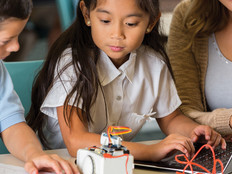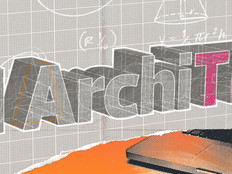How To I
Blueprint for the Future
Plan in hand, a Florida school district gives 2,500 classrooms a digital makeover.
How do you go about adding the latest technology tools to every classroom in your district? Methodically, class by class, building by building, with a plan that is continually improved as the changes roll out. This is the formula that Collier County (Fla.) Public Schools used to complete its education makeover. The result: The district is well on its way to transforming each of its 2,500 classrooms with projectors, document cameras, sound systems and interactive whiteboards.
It began with the vision stated in the district’s Technology Plan: “The Collier County School Board believes that all students will utilize technology to engage in critical thinking, problem solving and effective learning experiences, … will be afforded the opportunity of access to technologies. … Administrators, teachers and support staff will … use a variety of technologies. Technology will facilitate connectivity to enhance communication between and within the schools, the community and the home.” Even though similar sentiments exist in many school district technology plans, Collier decided to bring its stated vision to fruition.
When school officials think about technology in the classroom, the first thing that comes to mind is computers. However, computers are not the only digital tools that have an impact on instruction. Other necessary tools for educators include video projectors, interactive whiteboards, document cameras and classroom sound-amplification systems.
Collier Facts
- 45 schools, including two new charter schools and the new Lorenzo Walker Technical High School
- 43,000 students
- 25% more students took Advanced Placement tests from 2005 to 2006
- 74.7% is the current graduation rate
The Challenges
In 2002 Collier County Public Schools, located in southwest Florida, was providing new schools with state-of-the-art equipment as part of construction. This included mounted video projectors, sound systems, interactive whiteboards and digital cameras. Older schools were clamoring just for the video projectors! Discussions centered on developing a comprehensive and realistic plan for retrofitting older schools so that this technology would be available to all students in our schools.
The Plan
In 2003, the facilities and IT departments started to discuss the possibility of a retrofit. Capital funding was available, and using a centralized approach alleviated the difficulties that individual schools were facing in procuring and installing equipment. Using the expertise of instructional technology, maintenance (A/V) and purchasing staffs, the district evaluated the different brands of video projectors, document cameras and sound-amplification systems. This took time but by going slowly, officials made what they felt were important cost-saving decisions.
For example, at the onset the district planned to run a VGA cable, an S-Video cable, a coax cable and a three-prong RCA cable in the ceiling and down the wall. In the end, the setup chosen only required a coax cable, a VGA cable and a single video RCA cable plus the wires (coax and stereo) for the sound system. This saved the district thousands of dollars. Officials also designed a wall plate that has room for growth, allowing teachers to control all of the room’s technology from one spot.
Installers bid for the job and the district completed test sites to compare the work and costs. The project started in earnest in January 2005.
Reimagining the Classroom
The project involves much planning and coordination between IT, maintenance, purchasing, facilities, vendors and, most of all, the schools. In planning, the following needed consideration: wall-plate design; location of video projectors in the ceiling; access to electric and data ports; cabling standards; ceiling plates and video-projector mounts.
Currently the district is purchasing:
- Epson 82c video projectors — XGA/ 2000 lumens;
- Avermedia — Avervision 300p document cameras;
- mimio — a unique wireless tool that makes ordinary whiteboards interactive;
- Peerless universal mounts, ceiling plates and extensions
Throughout the year, teachers receive support as they use the equipment to provide daily instruction. It is easier than ever to use online resources because the students can all see, hear and understand. Principals are readily seeing the advantages of using this equipment for staff meetings, modeling their expectations for their staff.
One key part of Collier’s plan was to update a minimum of 10 classrooms every year in existing schools. Because of this decision, the district avoided creating a digital divide where some schools waited years to be updated. The district achieved its goal the first year, equipping more than 500 classes with new equipment. By the end of June 2007, it will have installed digital setups in more than 2,000 classrooms.
The Training
ITS officials provide both curricular and technical training to teachers and staff. Training is done after school in a minimum of two-hour blocks. The staff works with each teacher to label the cables and to do the sound and video checks.
Training on the mimio is provided at a separate time after the teachers have used the video projector and document camera for a few weeks. Staff members continue to develop workshops that will take the teachers to the next level of integration based on applying information technology and critical thinking skills to improve student achievement.
Impact
Everyone learns in multiple ways and technology provides these multisensory approaches. For all students, hearing the teacher clearly is an advantage in a busy classroom. We have found students are much more attentive in classrooms that include sound systems. The clarity and relaxed tone of the teacher’s voice brings calm into the class. Video projectors are wonderful tools to help all see the board.
The equipment that interacts with the projector, both the document camera and the interactive whiteboard, allows for, among other things, examination of 3-D objects and the manipulation of digital media. Obviously, this project is time- and labor-intensive. However, upon completion, every teacher in the county will be using technology that officials could only dream of a few years ago. It will make technology a seamless piece in classroom instruction. It is a dramatic change for our teachers and they are embracing it.
Collier County’s goal is to have these tools for all its schools, teachers and students. With these innovations, Collier hopes to capture the moment, embed the knowledge and look confidently to the future.
5 Reasons You Need a Whiteboard in Your Classrooms
- It accommodates different learning styles
- It maximizes the use of limited computer access by allowing multiple students to share a computer
- Students with limited motor skills can effectively use the boards
- It works well with other peripherals, from document cameras to video cameras
- It’s a kid magnet! Children love to learn and experiment with the whiteboards
Source: Mary Ann Bell, teachers.net
Teacher and Student Approved
Below are letters the IT team has received from teachers and students in the district.
“Just a note to tell you how much my students and I appreciate the technology package installed in my classroom. I teach at East Naples Middle School and I use my document camera, projector and microphone every day. Access to curriculum and student engagement has increased dramatically. How I teach has really changed. When I am planning for the week I always consider how I can use technology to enhance my plans. Thank you so much for the gift of new tools.” — East Naples, Fla., teacher
The equipment “helps teachers and students. Students pay more attention.” — Collier teacher
“Everyone can hear, even in the back of the classroom.” — Collier student
“It is easier to see the board.” — Collier student






